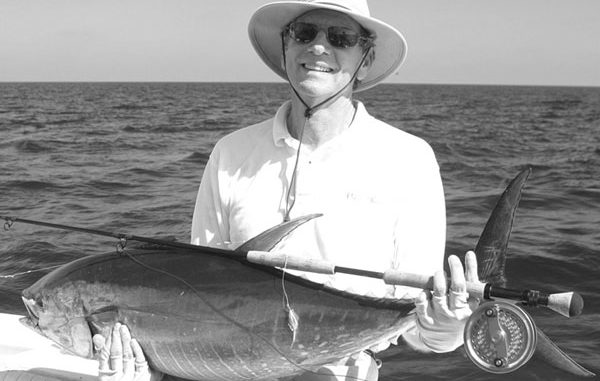
On a recent trip with Capt. Scott Avanzino out of Venice, Frank Genusa Jr. felt he had a good shot at setting a state record on dolphin.Once Avanzino had his party on a solid rip, the blue-green flashes began shimmering around the boat.
“I made one cast”, recalls Genusa, “and immediately hooked up to the biggest dolphin I’d ever seen. But when we got it up to the boat, it turned out my fly had caught a wire leader coming out of its mouth. It would’ve been a record if the rules allowed the use of metal attachments to flies.”
The rules to which Genusa referred are the Louisiana Outdoor Writers Association state fish records guidelines for the fly fishing division. The division, established in 1993, is for documenting the top 10 of each species caught on fly rod.
Nationally-renown outdoor writer Pete Cooper Jr. of Buras was instrumental in starting the division, and contributed many of the early records himself.
The inshore species saw a flurry of activity, but there was very little interest for the pelagics.
Part of the problem is that our fisheries in South Louisiana are as unique as our culture and way of life. Our waters are different, and even our fish behave differently. To be successful with offshore species, we needed a home-grown base of knowledge and experience.
Enter Roger del Rio. Over the years, del Rio has been the catalyst for bringing fly rodders with common interests together. For example, del Rio created the “Puddlers,” a group of anglers who fish from canoes and kayaks.
The term “puddler” is now in common use among fishing circles today to describe “one who fishes from a canoe or kayak.”
Del Rio always had a strong interest in offshore fly fishing, but needed to find others who could help build that knowledge base, as well as share charter costs, so he founded the “BigFish+10 Group.” The +10 signifies that most of the fish they target require a 10-weight or higher to subdue.
Since BigFish was founded, the number of records submitted to the LOWA each year has nearly tripled. There are about 30 members to this group. Some who have several listings in the top 10 of various species include Susan Gros, Chip Metz, David Coignet, Vic Tedesco, Rich Evans and Gary Parrish.
Parrish says the main differences between Louisiana and other states are where we target our fish, how we target our fish, and dealing with frequently off-colored water and an extraordinary amount of bait competition.
“I like to target jack crevalle, mangrove snapper and cobia in 40 to 150 feet of water around near-shore structure,” he said. “Reef fish such as amberjack, almaco jack, rainbow runners, red snapper and perhaps grouper are found in 100 to 200 feet around structure such as drilling or production platforms.
“You also have your ‘targets of opportunity’ category that include tripletail, cobia and jack crevalle at random flotsam, as well as bull redfish or tarpon that come in big pods across relatively shallow water.
“Farther out, you can troll rips or weed lines for predators such as wahoo, tuna, marlin, sailfish and dolphin, or you can fish deep structure such as floating platforms and drill ships to catch tuna, king mackerel and other species.”
Parrish has been on many trips with other members of BigFish, and keeps a log of information. He was kind enough to share his findings on gearing for each species.
• Amberjack — 12-14 weight with sinking line (400- to 600-grain), 200 yards backing, 8-foot lifting rod.
• Almaco jack — 12-14 weight with sinking line (400-to 600-grain), 200 yards backing, 8-foot lifting rod.
• Barracuda — 8-10 weight, wire leader with sinking line (400- to 600-grain), 200 yards backing, 8- to 9-foot casting rod.
• Blackfin tuna — 8 weight with sinking line (400- to 600-grain), 200 yards backing, 8-foot lifting rod.
• Bull dolphin — 8 -10 weight with floating or intermediate line, 200 yards backing, 8- to 9-foot casting rod.
• Jack crevalle — 12-14 weight with sinking line (400- to 600-grain), 200 yards backing, 8-foot lifting rod.
• King mackerel — 8-10 weight, wire leader with floating or intermediate line, 200 yards backing, 8- to 9-foot casting rod.
• Mangrove snapper — 8-10 weight with sinking line (400- to 600-grain), 200 yards backing, 8-foot lifting rod.
• Marlin — 14 weight with floating line, lots of backing (you will likely lose all your line and backing tangling with a blue).
• Rainbow runner — 8-10 weight with sinking line (400- to 600-grain), 200 yards backing, 8-foot lifting rod.
• Shark — 8-10 wire leader with sinking line (400- to 600-grain), 200 yards backing, 8- to 9-foot casting rod.
• Yellowfin tuna — 12-14 weight with sinking line (600-grain), 350-400 yards backing, 8-foot lifting rod.
• Wahoo — 8-10 weight, wire leader with floating or intermediate line, 300 yards backing, 8- to 9-foot casting rod
Lefty to Lake Charles
Speaking of big fish, there’s one coming to Lake Charles on Oct. 2 that you don’t want to let get away.
The Contraband Fly Casters are featuring “A Day with Lefty Kreh” to be held at the Southwest Fishing Club from 9 a.m. to 4 p.m. The event is free and open to the public.
Kreh, perhaps the greatest fly and saltwater angler of our time, has held numerous records, taught thousands to fly cast, and written more books and articles on fly fishing than anyone.
For details, visit http://cbfc0.tripod.com or call Ron Begnaud at (337) 477-7584.


